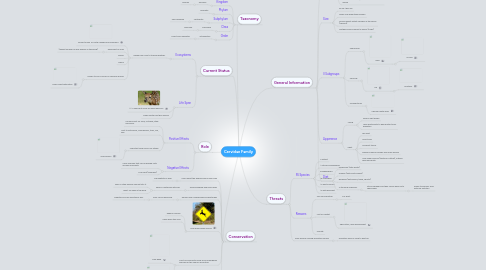
1. Current Status
1.1. Ecosystems
1.1.1. Range from cold to tropical whether
1.1.1.1. Frozen tundra of north Canada and Greenland
1.1.1.2. Rainforest of India
1.1.1.2.1. (largest number of deer species in the world)
1.1.1.3. Boreal
1.1.1.4. Alpine
1.1.1.5. Known to live in urban or suburban places
1.1.1.5.1. Small forest with paths
1.2. Life Span
1.2.1. 11-12 years but many are killed before 5
1.2.2. Males shorter life than female
2. Role
2.1. Positive Effects
2.1.1. Humans hunt for food, clothing, other resources
2.1.2. Host to flat worms, roundworms, ticks, lice, flies
2.1.3. Important food source for others
2.1.3.1. Grey wolves
2.2. Negative Effects
2.2.1. Carry diseases that can be passed onto animals and plants
2.2.2. Crop pest (browsers)
3. Conservation
3.1. Learn about the wildlife around your area
3.1.1. The habitats of deer
3.2. Secure garbage and recycables
3.2.1. Keep in containers with lids
3.2.1.1. Deer or other animals can get into it
3.2.1.2. Won't fly away in the wind
3.3. Reduce use of herbicides and pesticides
3.3.1. Deer can be posioned
3.3.1.1. Predators can be affected as well
3.4. Slow down when driving
3.4.1. Reduce road kill
3.4.2. Helps deer stay alive
3.5. Don't buy products made from endangered species for the sake of decoration
3.5.1. Deer head
3.5.2. Antlers
3.6. Protect its habitat
4. Taxonomy
4.1. Kingdom
4.1.1. Animalia
4.1.1.1. Animals
4.2. Phylum
4.2.1. Chordata
4.3. Subphylum
4.3.1. Vertebrata
4.3.1.1. Has backbone
4.4. Class
4.4.1. Mammalia
4.4.1.1. Mammals
4.5. Order
4.5.1. Artiodactyla
4.5.1.1. Even-toed ungulates
5. General Information
5.1. Antlers
5.1.1. Only males have antlers
5.1.2. Caribou is the only species with both male and female antlers
5.1.3. Antlers used for hunting and male to male fight for mate
5.1.4. Old antlers shed off, new ones grow out in the spring
5.2. Size
5.2.1. 20 lbs-1800 lbs
5.2.2. Males 25% larger than females
5.2.3. Moose largest extant member of the family (1800lbs)
5.2.4. Northern pudu smallest in family (20lbs)
5.3. 3 Subgroups
5.3.1. Capriolinae
5.3.1.1. Deer
5.3.1.1.1. Moose
5.3.2. Cervinae
5.3.2.1. Elk
5.3.2.1.1. Muntjacs
5.3.3. Hydropotinae
5.3.3.1. Chinese Water Deer
5.4. Apperence
5.4.1. Young
5.4.1.1. Dark or light brown
5.4.1.2. Have white spots to help protect from predators
5.4.2. Adult
5.4.2.1. Tail short
5.4.2.2. Snout long
5.4.2.3. Compact torsos
5.4.2.4. Powerful legs for woody and rocky ground
5.4.2.5. Lack upper incisors (teeth for cutting), instead have hard plate
5.5. Diet
5.5.1. Herbivores (eats plants)
5.5.2. Grazers (eats mostly grass)
5.5.3. Browsers (eats leaves, twigs, shoots)
5.5.4. 4 stomach chambers
5.5.4.1. Store chewed food then comes back up to chew again
5.5.4.1.1. allows to process food with low nutrition
6. Threats
6.1. 55 Species
6.1.1. 2 extinct
6.1.2. 1 critically endangered
6.1.3. 8 endangered
6.1.4. 16 vulnerable
6.1.5. 17 least concern
6.1.6. 10 data deficient
6.2. Reasons
6.2.1. Too much hunting
6.2.1.1. For sport
6.2.2. Lost of Habitat
6.2.2.1. Agriculture, land development
6.2.3. Climate
6.3. Deer decline causing predators decline
6.3.1. Predators have no food to hunt for
